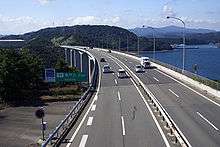Expressways of Japan
The expressways (高速道路, kōsoku-dōro, lit. "high-speed road", also jidōsha-dō (自動車道), lit. "automobile road" or "motorway") of Japan make up a large network of controlled-access toll expressways.
| Expressways of Japan 高速道路 自動車道 | |
|---|---|
.jpg) .jpg) .jpg) Expressway number signs for the Tōhoku Expressway, its parallel expressways, and the circular Ken-Ō Expressway | |
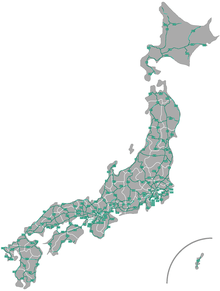 | |
| System information | |
| Maintained by the Japan Expressway Holding and Debt Repayment Agency, through its subsidiaries (East, Central, West Nippon Expressway Company Limited), the Metropolitan Expressway Company Limited, and others | |
| Length | 10,021 km[1] (6,227 mi) |
| Formed | 1963 |
| Highway names | |
| Expressways | Expressway E nn (E nn) (primary route) Expressway E nn A (E nn A) (parallel route) Expressway C nn (C nn) (circular route)[2] |
| System links | |
| National highways of Japan Expressways of Japan | |
History
Following World War II, Japan's economic revival led to a massive increase in personal automobile use. However the existing road system was inadequate to deal with the increased demand; in 1956 only 23% of national highways were paved, which included only two thirds of the main Tokyo-Osaka road (National Route 1).[3]
In April 1956 the Japan Highway Public Corporation (JH) was established by the national government with the task of constructing and managing a nationwide network of expressways. In 1957 permission was given to the corporation to commence construction of the Meishin Expressway linking Nagoya and Kobe,[3] the first section of which opened to traffic in 1963.[4]
In addition to the national expressway network administered by JH, the government established additional corporations to construct and manage expressways in urban areas. The Metropolitan Expressway Public Corporation (responsible for the Shuto Expressway) was established in 1959, and the Hanshin Expressway Public Corporation (responsible for the Hanshin Expressway) was established in 1962. By 2004 the lengths of their networks had extended to 283 kilometres (175.8 mi) and 234 kilometres (145.4 mi) respectively.[5]
In 1966 a plan was formally enacted for a 7,600 kilometres (4,722.4 mi) national expressway network. Under this plan construction of expressways running parallel to the coastlines of Japan would be given priority over those traversing the mountainous interior.[3] In 1987, the plan was revised to extend the network to 14,000 kilometres (8,699.2 mi). In April 2012, completed sections of the network totaled 10,021 kilometres (6,226.8 mi) [6][1]
In October 2005 JH, the Metropolitan Expressway Public Corporation, the Hanshin Expressway Public Corporation, and the Honshū-Shikoku Bridge Authority (managing three fixed-link connections between Honshu and Shikoku) were privatized under the reform policies of the government of Prime Minister Junichiro Koizumi. These privatizations are technically converting the corporations into stock companies with no stock sold to the general public, since the Government of Japan hold controlling shares in the successor companies. The expressway network of JH was divided into three companies based on geography - East Nippon Expressway Company (E-NEXCO), Central Nippon Expressway Company (C-NEXCO), and West Nippon Expressway Company (W-NEXCO). The Metropolitan Expressway Public Corporation transferred its authority to the Metropolitan Expressway Company, while the Hanshin Expressway Public Corporation transferred its authority to the Hanshin Expressway Company. The Honshu-Shikoku Bridge Authority became the Honshu-Shikoku Bridge Expressway Company, whose operations are planned to eventually be absorbed into those of W-NEXCO.[7]
Finances
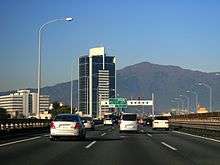
Japan's expressway development has been financed largely with debt. It was intended to make the expressways free when they are paid off. The Meishin Expressway and Tomei Expressway debt has been fully paid off since 1990. It was decided in 1972 that tolls would be pooled from all expressways to provide a single source of operating funds, since some sections were little used. Earthquake resistant construction methods have added to costs, as well as extensive soundwalling. In March 2009 (then) Prime Minister Taro Aso unveiled a plan to reduce tolls to ¥1,000 on weekends and national holidays. Tolls on weekdays would be cut by around 30 percent. According to the National Expressway Construction Association, 4.41 million vehicles use the expressways daily, driving an average of 43.7 kilometres (27.2 mi).[8]
National expressways
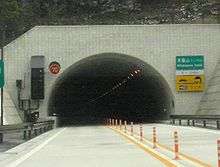
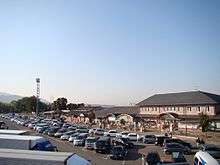
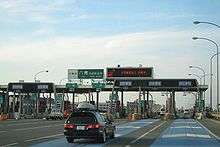
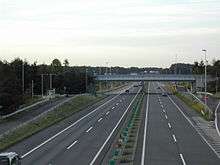
National expressways (高速自動車国道, Kōsoku Jidōsha Kokudō) make up the majority of expressways in Japan. This network boasts an uninterrupted link between Aomori Prefecture at the northern part of Honshu and Kagoshima Prefecture at the southern part of Kyushu, linking Shikoku as well. Additional expressways serve travellers in Hokkaido and on Okinawa Island, although those are not connected to the Honshu-Kyushu-Shikoku grid.
Features
Most expressways are 4 lanes with a central reservation (median). Some expressways in close proximity to major urban areas are 6 lanes, while some in rural areas are 2 lanes only with a barrier on the center line. 2-laned sections are built to a standard that allows conversion to 4 lanes in the future.[9]
Speed limits are normally 100 km/h (62.1 mph) , and a minimum speed of 50 km/h (31.1 mph) is also enforced. Vehicles unable to reach 50 km/h, such as tractors and mopeds, are forbidden from using the expressways.[10] Speed limits may also be reduced temporarily (due to adverse driving conditions) or permanently (in accident-prone areas) as speed limit signs can be adjusted electronically.
Many rest facilities such as parking areas (usually only with toilets or small shops) and service areas (usually with many more amenities such as restaurants and gas stations) serve travellers along national expressways.
Route numbering
On October 24, 2016, the Japanese Ministry of Land, Infrastructure, Transport and Tourism had recently introduced a new format of route numbering system for national expressways.[11] In this route numbering system, expressway route numbers begin with the prefix E (for non-circular route) or C (for circular route) followed by their respective numbers. Expressway routes are numbered according to the national highway routes that they are parallel with; for example, the Tōmei Expressway is assigned with the route code of E1 for being constructed in parallel with the Route 1. However, there are exceptions in this rule, as there are some expressways that are assigned with the two-digit numbers greater than 59 which are not used in the national highway route numbering system. The Tsugaru Expressway is an example of this exception, it is numbered E64, but it parallels Route 101.[2]
If there are more than one expressway being constructed in parallel with their respective national highways, newer expressways within the same corridor may have the suffix A at the end of their route numbers, while the earliest one is exempted from having the A suffix. For example, the Chūgoku Expressway and San'yō Expressway both run in parallel along the Route 2 corridor, but the San'yō Expressway is assigned the route code of E2 for being constructed first, while the newer Chūgoku Expressway is assigned the route number of E2A.[2]
Tolls
National expressways are expensive to use, with the 325.5 kilometres (202.3 mi) journey from Tokyo to Nagoya on the Tōmei Expressway costing ¥7,100 in tolls for an ordinary car.[12]
With a few exceptions, tolls on national expressways are based on distance travelled. When entering the expressway, one collects a ticket, which can be inserted along with the fare into a machine or handed to an attendant upon exiting the expressway. There is also an Electronic Toll Collection (ETC) card system installed in many cars which automatically pays at the toll gate. As of 2001 toll fees consist of a 150 yen terminal charge plus a fee which depends on the distance travelled. The rate of this fee depends on the type of vehicle as shown in the following table.[3]
| Type of vehicle | rate in yen/km | rate in yen/mile |
|---|---|---|
| Light car and motorcycle | 19.68 | 31.49 |
| Ordinary passenger car | 24.60 | 39.36 |
| Small and medium-sized truck | 29.52 | 47.23 |
| Large-sized truck | 40.59 | 64.94 |
| Special large-sized full trailer | 67.65 | 108.24 |
Tolls are always rounded to the nearest 10 yen and include consumption tax. If there are two or more possible routes from the entrance to the exit, the toll will be calculated based on the shortest (cheapest) route.
Tolls collected from all routes are pooled into a single fund and are used to repay the entire network.[7] It is expected that all national expressways in Japan will be fully repaid 45 years after privatization (2050).[13]
Some future national expressways are planned to be built according to the New Direct Control System, whereby national and local governments will absorb the burden for expressway construction[14] and operate toll-free upon completion.[15]
Urban expressways
Urban expressways (都市高速道路, Toshi Kōsokudōro) are intra-city expressways that are found in many of Japan's largest urban areas. Due to lack of space many of these expressways are constructed as viaducts running above local roads. The two largest networks are the Shuto Expressway in the Tokyo area and the Hanshin Expressway in the Osaka area. There are other smaller networks in Nagoya, Hiroshima, Kitakyūshū, and Fukuoka. Each network is managed separately from each other (the Fukuoka and Kitakyūshū Expressways are managed by the same company but are not physically connected to each other).
Safety
In 2019, there were 163 Fatalities, 527 Serious Injury and 11 702 Sight Injury on Expressways of Japan, chich is a performance still better than in 2018[16].
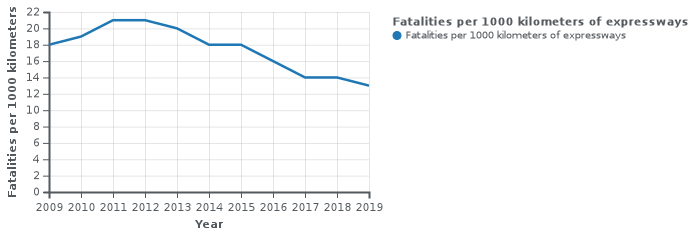
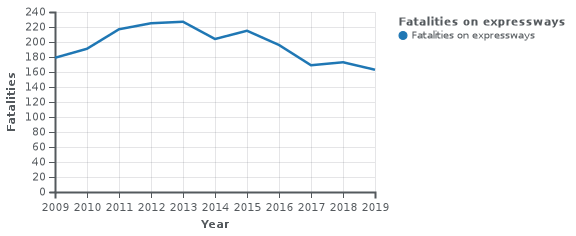
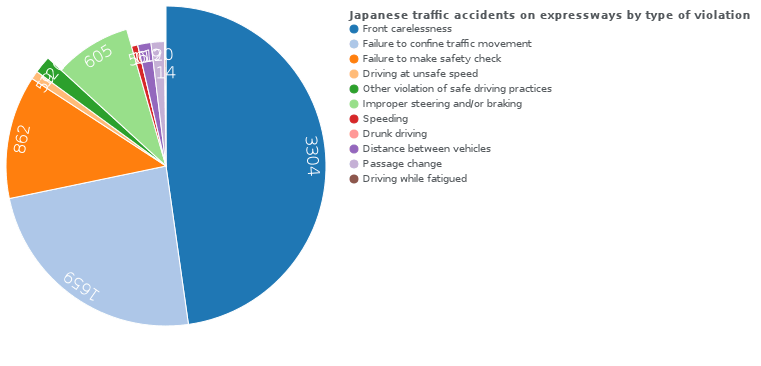
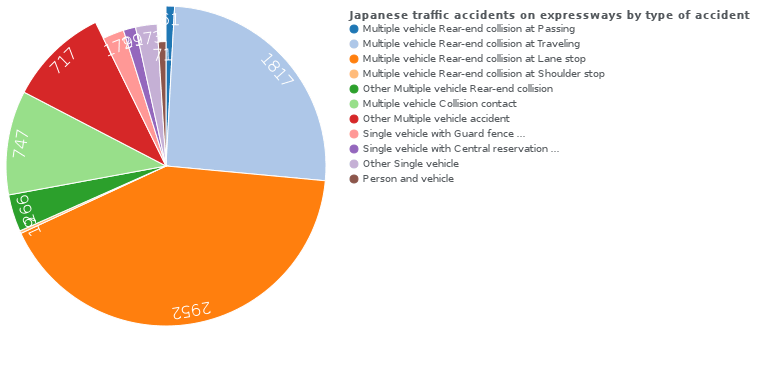
Others

All roads in Japan that are built to expressway standards (including national and urban expressways themselves) are known as Roads for motor vehicles only (自動車専用道路, Jidōsha Senyō Dōro). If a road for motor vehicles only cannot be classified as a national or urban expressway, it may be classified into one of the following categories.
- National highway for motor vehicles only with national expressway concurrency (高速自動車国道に並行する一般国道自動車専用道路, Kōsoku Jidōsha Kokudō ni Heikōsuru Ippan Kokudō Jidōsha Senyō Dōro)
- Roads in this category are built to facilitate future incorporation into the main route of a national expressway. Examples include the Michinoku Toll Road, the Higashi-Mito Road and the Futtsu Tateyama Road.
- National highway for motor vehicles only (一般国道の自動車専用道路, Ippan Kokudō no Jidōsha Senyō Dōro)
- Roads in this category are national highways built to expressway standards as designated by the Minister of Land, Infrastructure and Transport. Examples include the Ken-Ō Expressway and the Tōkai-Kanjō Expressway.
References
- Ministry of Land, Infrastructure and Transport. "Toll and Toll-free Roads in Current Arterial High-standard Highway Network" (PDF). Retrieved 2017-11-09.
- "What is the Expressway Numbering System?". Ministry of Land, Infrastructure, Transport and Tourism of Japan. Retrieved 2017-08-22.
- Kimura, Fukunari; Maeda, Mitsuhiro (November 2005). "Transport Infrastructure Development in Japan and Korea: Drawing Lessons for the Philippines" (PDF). Archived from the original (pdf) on 2007-09-28. Retrieved 2008-04-11.
- Ministry of Land, Infrastructure and Transport. "History of Japanese Roads". Archived from the original on 2008-04-24. Retrieved 2008-04-11.
- Ministry of Land, Infrastructure and Transport. "Roads in Japan - Metropolitan Ring Roads". Archived from the original on 2007-12-09. Retrieved 2008-04-11.
- http://www.mlit.go.jp/road/road_e/pdf/ROAD2014web.pdf
- Mizutani, Fumitoshi; Uranishi, Shuji (2006). Privatization of the Japan Highway Public Corporation: Policy Assessment (pdf). 46th Congress for the European Regional Science Association. Volos, Greece. Retrieved 2008-04-11.
- Nagata, Kazuaki (December 16, 2008). "A highway system that ever exacts toll". The Japan Times.
- "NEXCO-Central Business Outline" (pdf). Retrieved 2008-04-13.
- The Traffic Bureau of the National Police Agency (2001). Rules of the Road. Japan Automobile Federation. pp. 72–74.
- "Japan's Expressway Numbering System". Ministry of Land, Infrastructure, Transport and Tourism of Japan. Retrieved 2017-08-22.
- Zen-Nippon Dōro Chizuchō 全日本道路地図帖 [All-Japan Road Atlas]. Tokyo Chizu Shuppan. 2003. p. 155.
- "Framework of Agency's Business". Japan Expressway Holding and Debt Repayment Agency. Retrieved 2008-04-13.
- "Cooperation on New Direct Control System Sections (新直轄方式区間への協力 Shinchokkatsu Hōshiki Kukan e no Kyōryoku)". Archived from the original on 2012-07-31. Retrieved 2008-04-13.
- "New Direct Control System (新直轄方式)" (in Japanese). Nishinippon Shimbun Wordbox. Archived from the original on 2009-06-29. Retrieved 2008-04-13.
- https://www.e-stat.go.jp/en/stat-search/files?page=1&layout=datalist&toukei=00130002&tstat=000001027457&cycle=7&year=20190&month=0
External links
- Ministry of Land, Infrastructure and Transport, Road Bureau(in English)
- Map of expressway routes (in English)
- 全国の高速道路ガイド (in Japanese)
